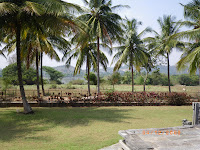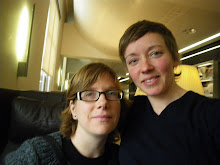Colours and markets
One striking element of India is the colour. Everything is so colourful: women's saris, men's shirts and dhotis, flowers, trucks, stalls etc. And there are stalls everywhere. People sell anything, everywhere, be it coconuts, a few mangoes, flowers or juices. Here are some pictures of stalls and shops.






Transport
Something that takes a bit of getting used to is the traffic. Traffic rules are very different, or rather more relaxed.. and crossing a road can take us a long time. We are getting better at it now and do not scream as rickshaws hurtle towards us (usually hoping we'll get in) anymore.
Indians use their horn a lot. So the noise coming from roads is quite impressive. Add to this the tunes each care plays as it reverses and he comedy horns (can you download a horn-tone?)..
All sorts of transport share the road: buses, trucks, cars, auto-rickshaws, cycle-rickshaws, animal-rickshaws (donkey, horses, etc), motorbikes, scooters, carts pulled by men or bulls, pedestrians, cyclists, etc. Everything goes, all on the road. And what's also impressive is how many people (or bananas, or boxes, or chickens...) you can fit into any one of these. We've seen over 15 kids in a rickshaw, we experienced being 9 in a small car (think Panda), 11 in a rickshaw, 19 in a 4x4, and what must be well over a hundreds in a bus - and there's always room for another one.. or two.
Bullock cart
Buses
Keeping cool on trains. Laundry service.
Relaxed attitude
Most Indians work very hard. It's amazing what people can do in this heat! But often work and life in general is done in a very relaxed way and I am still amazed at how people can relax nearly everywhere and in most situations: a motorbike is coming straight towards you, fast - don't jump out of the way, just relax, it will go round you at the last minute....
What I admire the most is how people can sleep anywhere: on the pavement of a dual carriageway, in a temple, anywhere really, even if it is noisy, busy, dangerous, situations we would remain painfully awake and worry in. The animals are the same: dogs sleep in the middle of the road, undisturbed, while vehicles nearly crash into each other to avoid them. This picture is an example of a very relaxed dog sleeping balanced on chairs occupied by people.
We're coming to the conclusion that it's all about the fear factor and that we're too scared to relax most of the time!
Food
Simply superb, tasty, different in each state, so full of flavours and spices. We eat with the right hand (the left is for other things - so never ever touch food with your left hand) on banana leaves or stainless steel plates. Most restaurants have set times for certain food. For example idly and tea in the morning. Thali (full meals) only at lunchtime and dosas, chappatis, pooris, etc in the evening. The 'Veg hotels' are not hotels but restaurant/canteens serving fresh vegetarian food and a thali will cost you 25-40 rupees (about 35-45p). It is very easy to get good vegetarian food in India.
Paratta and curry. Harriet's favourite: rava idly.
Sylv's favourite: Uttapam.
The tea is with milk and sugar as default and served in a stainless steel cup with a deep stainless steel saucer and the trick is to pour the tea from the cup to the saucer and vice-versa until the tea is not too hot. A real art ;-)
And cure for the Dehli-Belly... (love the branding too)
Hygiene and toilets
Not your usual subject in a blog but hey, I'm am sure you are wondering what the business is about toilets (especially since I mentioned above that the left hand is reserved). Well, there's no loo roll (except in the tourist shops). It is seen either as disgusting or a luxury item for the rich city people and westerners. All excrements are understandably thought of as dirty and should be discarded and cleaned with water. So why would you use toilet paper and keep your dirty things on a piece of paper? Instead there is water. The toilets are also mainly of the squatting-style (here called Indian style) so that makes the whole cleaning process easier and to be fair we are finding this technic much more hygienic and clean and a bit of coolwater is always welcome ;-)

This is a fine example of East meets West. The western style toilet that could also be squatted on. No idea how you use it Western style though and it is rather dangerous to get on and off, we're dicing with broken ankles here!!

This is a fine example of East meets West. The western style toilet that could also be squatted on. No idea how you use it Western style though and it is rather dangerous to get on and off, we're dicing with broken ankles here!!
What's also quite surprising, especially the first time as you sort of don't expect it, is that there are urinals for women. Sylv took a picture to prove it!
Ladies' urinals.
That said, toilets are not always used or available and it is quite shocking for us to see so many people busy at the side of the road or in empty patches of land, beaches, etc.... The need for sanitation is so great, a shared loo such a luxury.... so much to do! This poster is trying to educate people in Hampi where a row of loos without walls or doors stood abandoned

Washing
And you thought that emptying the washing machine was a chore?! Think again. Here washing is done by hand in the river or at the pump and clothes get a good bashing on a stone. They are then dried on the grass or on bushes, whatever is available nearby. We have become very good at hand washing too but from the comfort of our hotel bathroom - we're trying to keep up with everyone else, surrounded by clean saris and perfect white shirts!
People
What really has made our trip so far have been the people we've met. So many smiles! So many 'welcome to India's and so many long conversations about who we are, where we're from, why we're here and what we're up to - usually to half the population of the town/ village and have started asking the same of everyone we meet.... Here are a few pictures (amongst maybe hundreds as we are asked for pictures all the time - H looks like a teacher and Sylv's working on her Madonna impression..)


Boys playing football.


The whole sales team in a clothes shop after an afternoon trying things on, drinking tea and discussing jobs, family relationships and internet dating (!).

And we loved this meeting: a bus load of police-women in uniforms who took care of us ;-)
Christianity
Christianity
Religion is ever-present in India. Other posts on this log are full of temples ;-) What's interesting is how the religions cross over. For example, in Christian churches, Mary or Jesus will be worshiped and decorated (with flowers, flashing lights, etc) like a Hindu god usually is. See pictures below.











































